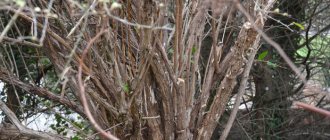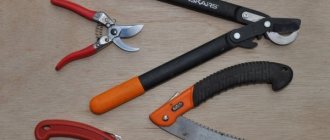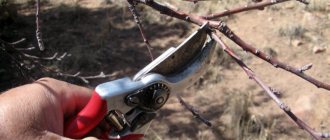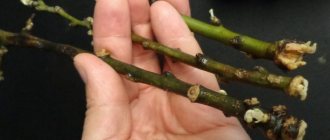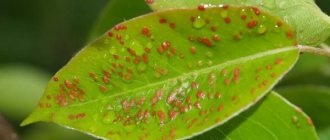Look at your pear. Are you happy with her appearance, did you buy her from a reliable nursery? Then you don’t have to do any formative pruning; the tree is already properly formed. Nurseries sell pear seedlings with a branched crown, with a dominant conductor and weaker side shoots; all you have to do is maintain the tree shape specified by the manufacturer. We will deal with the remaining cases of pruning a pear tree in order.
- What is the difference between pruning an apple tree and pruning a pear tree?
- When to prune a pear
- General rules for pear pruning
- Removing old and unnecessary branches on a pear tree
- Forming a pear
What is the difference between pruning an apple tree and pruning a pear tree?
In general, the rules for pruning a pear are similar to pruning an apple tree. The crown begins to be formed in the year of planting in order to obtain well-lit trees with evenly distributed shoots. However, reducing long growth in the year of planting is more necessary in the case of growing apple trees than pear trees. If strong growth is not required in the year of planting and it is necessary to reduce the supply of nutrition to the above-ground part, seedlings for planting a garden are grown for a year less and pinched. This prevents strong growths from occurring. Pruning of the pear is then continued, leaving 1 - 2 growth points at intervals of 1 year.
It is customary to cut out all shoots with rosettes of leaves from an apple tree. In a pear, if the crown is narrow and elongated, you can leave some of the strongest shoots with rosettes of leaves. Next year they will bear flower buds.
Leaf buds: sharp, elongated, tightly fitting on annual shoots;
Flower buds: round in shape, protruding slightly on the two-year-old part of the branch. The older flower buds form fruit bags. Flower buds form on short fruiting branches.
Fruit bags: thickenings at the end of the fruit branch that ultimately produce fruit. Most often, new flower buds form again on the fruit bags.
As a rule, it is enough to regularly carry out sanitary pruning on a pear tree, remove excess shoots, and reduce the number of branches that are too thick, growing at an acute angle, intersecting and thickening the crown. When forming pear trees, you should not leave branches older than 6 years, since the thickened crown allows little light to pass through, which prevents bud set, fruit growth and the formation of new shoots with terminal flower buds.
If the diameter of the pear branches is more than half the thickness of the conductor, they are removed during the formation of the first tier of the crown in order to stimulate the growth of other shoots.
Thickening shoots on the pear are removed
Soils, unfavorable climatic conditions, as well as errors in agricultural technology and plant protection
Nurseries produce pear seedlings with a branched crown, which should have a dominant guide and weaker side shoots.
All trees planted should be healthy and aligned in blocks in terms of plant size (one-dimensional planting material makes further work in the garden much easier).
Growing General Leclerc pear trees using drip irrigation
The rules for pruning a pear are similar to pruning an apple tree, and sometimes completely coincide. From the first years, crowns are formed, which will subsequently be well-lit, with evenly distributed shoots.
General rules for pear pruning
1 Prune the pear tree in late winter on a dry day: during the dormant period before the pear tree begins to actively wake up in early spring.
If it rains or snows while pruning a tree, there is a higher risk of infection entering the wet cuts.
2 Prepare your tools carefully. Have sharp, clean pruners, loppers and a pruning saw.
3 Make slanted cuts: Slightly slanted cuts will help prevent water from getting into the cut and causing contamination. Try not to leave small stumps.
4 Cut off no more than 10-20% of the branches every year. If you prune too much, your pear tree will begin to send out strong, vertical, useless branches.
As the young pear tree grows, the leader should always be taller than the surrounding branches. Pear tree branches naturally grow vertically, but when they begin to bear fruit, they spread out - the weight of the fruit pulls the branch down into a more horizontal position.
Remove fattening shoots and tops in a timely manner
If you cannot achieve an angle of at least 60 degrees between the branch and the tree trunk, then remove the branch.
Pruning and shaping increases the amount of sunlight in the center of the tree. As a result, your pear will bear fruit faster and in greater quantities.
Form an open crown of the pear to make it easier to reach each part of the tree when processing. This also ensures good air circulation around the branches, helping prevent disease.
Limit pruning of mature pear trees in areas where fire blight is a problem and rust is common. Use as few accidental and careless cuts as possible, and handle damage carefully.
Autumn and summer pruning
If in the first 2 years after planting you need to form the crown of a young pear only in the spring, then in all subsequent years you need to remove excess branches in the summer and autumn.
In the summer, you can get rid of damaged branches. You can also shorten shoots that are developing too actively. All manipulations should be completed by the end of June. Removing branches and shoots during the period of fruit formation and ripening can negatively affect the yield.
In the fall, we remove branches damaged by pests and diseases. At the same time, you should get rid of the damaged bark. Branches must be removed at least 20 days before the onset of frost. And since there is always a possibility of early frosts, it is advisable to complete all work before the end of September.
You should not delete a large number of branches in one go. If the tree is too overgrown, first remove those branches that thicken its crown the most. After the cut areas have healed, remove the remaining shoots.
Removing old and unnecessary branches on a pear tree
1 Trim any dead or damaged branches, starting at the point where the damage occurs. It is possible to cut out an entire large branch if all the wood is damaged or dead. They bear no leaves during the growing season, when the rest of the tree blooms and turns green. Aging fruit formations should also be removed. Instead, several strong annual growths with an apical fruit bud are left.
Removing dead or damaged branches is one of the few times you can prune a tree in the spring or summer.
2 Don't forget to cut out the root shoots. If a tree has shoots growing at the base of the tree from the main trunk, they are called shoots and are actually part of the root system rather than the fruiting system on top. They are of no benefit to your pear.
3 Remove straight vertical shoots coming from the main branches (fatifying). They differ from other branches in that they are located on the main branches, do not have a bend, are most often short and grow straight towards the sky.
4 Try not to cut off fruiting shoots. Fruit branches form on two-year-old wood, so on very young trees it is better not to touch them. They appear as smaller, curved shoots growing from the main branch, with small buds or fruit buds at the tip.
A year after fruiting, 1-2 more fruit branches appear in this place. After 6 or 7 years the branch will be overloaded with fruit buds, at which point you can prune them back to allow new fruit shoots to form elsewhere. The only reason to prune fruit branches is if the branch is dead or damaged. You can find out how and why to prune pears in summer here >>>
When is spring pruning performed?
It is important to carry out spring crown treatment activities on time. The tree is sensitive to frost, so violation of technology can lead to loss of yield and even death of the seedling.
The timing of pear pruning in the spring is determined by the weather conditions of the region and the nature of the particular season. The time for safe processing is when severe frosts have already passed, but the tree itself has not yet “woke up”. This period usually occurs at the end of March or beginning of April.
All tree pruning activities must be carried out before sap flow begins.
The main sign of the time for crown treatment is the establishment of stable positive temperatures day and night. An increase in daylight hours, warmth up to +5 °C, and increased soil and air humidity help the tree to quickly recover from injuries and put all its energy into laying buds and fruits.
Forming a pear
When pruning in the nursery, they try to give the pears the shape of a wine glass with evenly spaced branches. Leave about 15-30cm of air space between healthy branches to ensure good air circulation and reduce the risk of fungal infections.
If you yourself have to form an annual pear seedling, then in the spring cut the trunk to a height of 50 cm from ground level, this promotes the formation of shoots from the lower buds. In the fall, annual shoots are also shortened, leaving several buds for the formation of new branches in the spring. The next year, the central stem is shortened by 1/4, the side branches are cut off under the ring. Side shoots serving as the basis of the crown are left, but no more than 4, extending from the trunk at an angle of 45°.
Formative pruning of pears from the year of planting to the third year of cultivation
The tree should be maintained with one central leader or main trunk in the center, with several wide-angle branches arranged around the leader. Pear trees naturally develop narrow, angular, vertical branches. To train branches to grow at the correct angle, weigh them down and tie the branches to stakes in the ground.
Step away from the tree from time to time and look at its overall shape as you prune to ensure you're getting the right shape and clearing the overgrowth effectively. But when pruning, it is important to be guided by a sense of proportion: if there are a bunch of branches around you as tall as Ilyich’s hut near Shushenskoye, call it a day.
Branches that grow against the main flow of outward-facing, ascending branches will crowd out other branches and give your tree an overall chaotic appearance. Trim them where they meet a larger branch.
Remove branches that form a “fork”
Thin out competing branches. If you find two or more branches growing from the same place at a narrow angle or from different points in parallel, choose the healthiest branch to save and prune the rest.
Pruning is not strictly necessary, but it can help your tree grow stronger, fruit-bearing branches, which optimizes harvest. Pruning also helps control the size and shape of the tree.
Is it possible to trim the top of a pear tree?
You can reduce the growth of a young pear if absolutely necessary (for example, if it is too tall), but this is not good for the tree. But such pruning of an adult pear can be very harmful, and perhaps the tree will no longer bear fruit. If your pear tree is too tall, do some light crown pruning while the tree is dormant rather than cutting off the entire top. Fertilize pears two weeks before flowering in the spring of their second year and thereafter. You can also use ammonium nitrate as a fertilizer for pear trees. But if severe pruning was carried out on an adult neglected tree, the trees should not be fertilized in the spring.
Rules for forming the crown of a pear tree
If you have never grown pears before, you probably think that pruning an old and a young plant is the same process. This is a misconception; in fact, each age of the tree has its own pruning rules for crown formation and healthy branch development.
Pear pruning scheme
There are certain rules for pruning a plant from the moment of planting until the start of fruiting. These also include crown formation schemes. To prevent pruning from becoming stressful for the tree and causing its death, use the following materials and tools:
- ladder or stepladder;
- pruning shears for cutting branches up to 2 cm in diameter;
- lopper for thicker branches (it has shorter handles than pruning shears);
- garden knife;
- saw for cutting the thickest branches.
- Remedy for protection against diseases Garden var
Use a stepladder, sharp gardening tools, and a garden varnish to handle the cuts to ensure proper pruning.
All tools must be sharpened and disinfected before use. In addition, you will need garden wax or oil paint to cover the cuts.
Pruning pear seedlings after planting
As soon as you plant a pear seedling, you need to do the first, main pruning, which has 2 goals at once:
- The root system of the tree may be damaged during planting. In order for it to recover as quickly as possible, it needs nutrition, and shortening the branches will help provide it.
- The conductor will be shortened and thereby laid the pattern for the formation of the pear in the future.
Immediately after planting, prune the seedling to lay the foundation for the future crown.
In the autumn of the first year of growth, the tree will not require pruning, since it was carried out when planting in the spring. If you follow all the rules, at the first stage you will provide the pear with good conditions for healthy crown growth and its formation. You will only need to remove damaged shoots if necessary.
Pruning annual and young pears
A one-year-old seedling that was planted last year needs to trim the trunk by at least a quarter of the total length (25%). This will help the crown of the plant become more branched. The side shoots are also shortened, but they are cut to the first bud.
After another year of the tree’s life, the top of the trunk should be shortened by 25–30 cm, and all branches of the tree by 6–8 cm. In order for the crown to form correctly, the lower branches must remain longer than the upper ones. This pyramid-like crown shape is considered one of the best for pear fruiting.
After completing all these stages of pruning, follow the rules for caring for a pear plant. They are as follows:
- Every year in March, do sanitary pruning to remove dry shoots and twigs with signs of disease.
- After 2 weeks, carry out the formative stage according to the same scheme as the first time. As the pear grows larger, the rate of germination of new shoots will decrease, and formative pruning can be carried out once every 3 years.
For mature and mature pear trees, one pruning every 3 years will be sufficient.
Formation of tiers in a pear seedling
Within a year of planting, the pear tree had already taken root and fully adapted. At this time, you need to begin the process of crown formation, which lasts three seasons and consists of several stages.
Sparsely tiered pear crown
This type of green mass is the most common and resembles natural forms. On the trunk, the shoots are arranged in tiers of 2-3 pieces or individually.
Formation of the crown of an annual seedling begins in early spring. For this purpose, a bole zone is allocated on the main conductor. It is located at a distance of 0.5 m from the surface of the earth. If it is smaller, then caring for an adult crop will be problematic. In the case of an enlarged bole, the pear will lose resistance to sub-zero temperatures and sunburn.
Above the trunk, another 30-40 cm must be measured, on which the skeletal shoots of the first tier will be located, and the conductor must be removed. The cut needs to be made above a healthy and developed bud - a shoot will appear from it, a continuation of the trunk. During crowning, the main branch should remain 15-20 cm higher than the shoots growing on the sides.
Another year later in the spring, gardeners clear the trunk of growth. There should be 3 branches left in the first tier, the distance between them along the trunk will be 10-15 cm. Their length is almost the same along the same horizontal line. Their circumferential growth will ideally be 100-120° between themselves. The remaining side shoots must be cut off or bent for a while so that they are parallel to the ground. This approach will slow down their growth, and, on the contrary, increase productivity.
Attention!
Branches whose length does not exceed 30 cm do not need to be removed - fruits will be set on them. They are almost not prone to growth.
On a three-year-old tree, a new one is laid 0.5-0.7 m from the lower tier. It is formed by 2-3 future skeletal shoots. The algorithm is the same as when forming the first tier. If the conductor has grown excessively, then it must be shortened. Branches that have been bent should not be touched. But if they make the crown very thick, then they will have to be shortened or completely removed.
On a four-year-old pear, 40 cm from the second tier, you can leave 2-3 branches of the third level. After 1-2 years, the conductor on the trunk must be shortened to the upper skeletal shoot growing from the side. The crown height should ideally be at least 4-4.5 m.
How pear trees react to pruning
Sometimes a pear tree does not react to pruning the way you would like it to, and grows “in the wrong steppe.” Such disobedience depends on the variety and its inherent type of growth. Therefore, sometimes light pruning is combined with other techniques, for example, bending. There are varieties with apical (apical) dominance of shoots, and others with lateral dominance. There are those with good shoot formation, and those with poor shoot formation. There are varieties with a right angle of shoot emergence, and there are varieties with an acute angle (mesotonic and basiconic).
Varieties with a mesotonic type of branching with a wide angle of branching of branches are perfectly formed: Pamyati Yakovlev, Avgustovskaya rosa, Lastochka. It is a pleasure to form such varieties - we cut the young seedling to a standard height of + 20 cm and remove unnecessary side shoots in the summer - the tree forms itself. The forming scheme for such pears is sparsely tiered.
And a variety like Bryanskaya Krasavitsa has apical dominance. Those. all the growth force goes into one single shoot, which simply clogs the rest. It is impossible to form such a tree by pruning! When pruning, you get one or two shoots, but with such sharp angles that they literally run parallel to the trunk. Such varieties are formed with horizontal cordons. This is when one shoot is kicked out and then bent. The shoots that grow from the bending places are thinned out and again bent in the opposite direction, etc.
Tree care after pruning
After pruning, you need to properly care for the pear. This is a prerequisite for it to bear fruit well and better withstand the procedure of thinning the branches. Gardeners advise adhering to the following rules:
- All branches must be disposed of after pruning. They must be removed from the site and burned. This is especially true if the shoots are sick, with signs of fungal infections.
- After pruning, be sure to use garden varnish. All cuts with a diameter greater than 1 cm should be covered.
- The pear needs to be sprayed after pruning. This is an excellent prevention of fungal infections. Copper sulfate 3% or iron sulfate 3% is suitable as a working solution. If the buds have not yet blossomed and swelled, you can also use Bordeaux mixture. It is effective, but you should be careful with concentration. This drug may cause chemical burns.
- Whitewashing the trunk. It is customary to whiten trees in the spring. This procedure not only helps protect the bark from the formation of frost holes, but also disinfects and helps destroy the larvae of harmful insects.
- Digging the trunk circle. This procedure must be performed after all the previous ones. It helps improve soil permeability. For young trees, digging is especially important.
You can treat pears against diseases and pests throughout the season. If signs of damage appear, there is no need to wait until autumn. Treatments can be carried out in the summer, but taking into account the waiting period. For preparations containing copper, it is large. That is why it is not recommended to treat pears on which fruits have formed with them.
On a note!
It is prohibited to spray trees during flowering. This can negatively affect pollination.
Pruning old trees requires a special approach. For such pears, removing a large number of branches can be very stressful. You can smooth out this moment a little by spraying the tree with Epin solution or another preparation that helps adapt to environmental conditions.
Pruning young trees, if done correctly, cannot in itself cause branches to dry out and wilt. If this happens, you need to look for the problem in other factors. This is often due to insufficient rooting. You can use the drug Heteroauxin or any other root formation stimulator.


